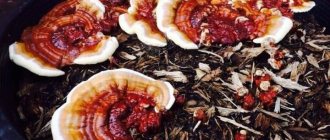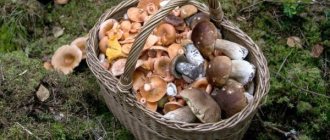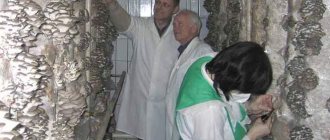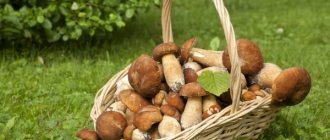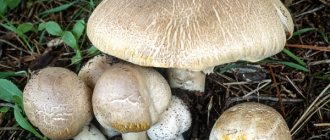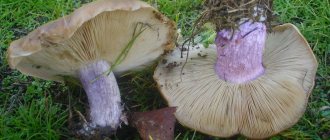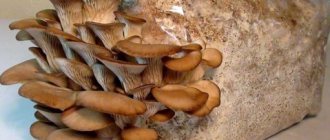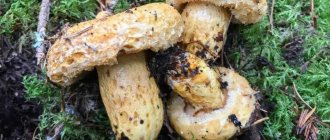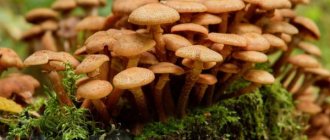The reishi mushroom or lacquered tinder fungus (lat. Ganoderma lucidum) has become widespread in regions of various countries around the world. It is a subspecies of the well-known polypore family. It earned its fame due to its chemical composition. It was discovered in Asia many decades ago. In Russia, the medicinal reishi mushroom began to be used in traditional and folk medicine relatively recently.
Description and value of the mushroom
The reishi mushroom is rarely found in nature, so it was once of great value. This saprophyte is considered an annual. But sometimes he lives for 2 or 3 years.
Botanical description:
- Mushroom body. Reishi consists of a stem and a cap.
- Hat. The color is variable, the mushroom can take on different shades - from reddish to purple. The hat is shaped like a human kidney. The maximum diameter is 25 cm. The surface is wavy. The mushroom is smooth and shiny. You can see many growth rings on the cap.
- Leg. Its length can reach 30 cm, diameter – 3 cm.
- Pulp. In young individuals it resembles a white sponge. Over time, it thickens, becomes woody, taking on a brownish tint.
Reishi mushroom has no smell or taste. There is only a bitter taste.
The mushroom is valued for its medicinal properties - it strengthens the body, has antibacterial, antiviral and antitumor effects, removes toxins and protects against radiation.
What is another name for reishi mushroom?
Reishi is the name given to a unique mushroom by the Japanese. Translated into Russian it means “mushroom of spiritual power.” The mushroom Ganoderma lucidum belongs to the genus Ganoderma, family Polyporaceae. It is also called:
- Mannentake is translated from Japanese as “ten-thousand-year-old mushroom.”
- Lingzhi is translated from Chinese as “mushroom of immortality.”
- Ganoderma shiny.
- Varnished tinder fungus.
The mushroom is especially valued in Japan and China - here it is considered the source of eternal youth.
Reviews
Reviews from people who took Reishi mushroom:
Elena: I’m a skeptic by nature, I’m used to checking and Googling everything (and I think that’s right). In 2022, I was diagnosed with an autoimmune disease associated with joint damage. The onset was acute, and the doctors said that such a manifestation of the disease was even good. But the problem is that there is still no clear treatment protocol. It's symptomatic and that's all. There are certain recommendations (don’t sunbathe, for example, don’t take hormonal pills), but that’s all. As a result, on the forum I found people with the same diagnosis. And I simply tracked what helped them recover. Among other things, there was also Reishi mushroom extract. I thought for a long time, but realized that it was unlikely to get worse. As a result, in September 2022, tests and x-rays showed remission. What is it, Reishi, or the new gluten-free diet? I don't know, but the fact remains a fact. I don’t specifically write a diagnosis because I’m afraid that people will blindly start repeating it. But you have to think, estimate, look for information.
Inna: I lived in Vladik until I was 17, and many people here use Chinese medicine recipes. My mother told me that at the age of 11-12 I had asthmatic bronchitis. Nothing really helped. And then they almost secretly treated me with Reishi mushroom. Bronchitis went away after six months of treatment. The pediatrician said that I had simply outgrown it. But my mother is sure that it was the mushroom that cured me.
Alexey: I have a very negative attitude towards dietary supplements, large markets of phytoproducts (such as Ayherb), I consider this to be selling air to a population that has been “banned by Google”. But somehow an interview with mycologist Vishnevsky caught my eye. He made me moderate my ardor a little. So far I have only taken Reishi mushroom extract, and only as an immunostimulant. Or rather, as a means that will help me survive the move to Siberia without colds (for work, I myself am from Sochi). I drank for several months, starting in August. Well, what can I say, the winter has passed, and I didn’t even have a runny nose. And my classmate, he is a general practitioner, said that from time to time he drinks this course.
Edible or not?
The varnished tinder fungus has a pronounced bitter taste, and therefore is classified as an inedible mushroom. It is used only for medicinal purposes. The mushroom is taken in the form of:
- tinctures;
- teas;
- dietary supplements;
- tablets;
- extracts;
- powders
The miraculous properties of the mushroom are due to its unique composition, which contains:
- polysaccharides - they strengthen the immune system;
- amino acids - they remove waste and toxins from the body;
- organic and polyunsaturated fatty acids - they prevent the formation of tumors.
The lacquered tinder fungus also contains coumarins, saponins, triterpenoids, phytoncides, flavonoids, alkaloids, vitamins B, C, D, micro- and macroelements (copper, zinc, selenium, phosphorus, sodium, manganese, magnesium, sodium, calcium).
Official opinion of doctors
Official medicine does not question the benefits of Reishi mushroom. You can see capsules, infusions, teas with mushroom powder in pharmacies. Ganoderma is included in medicinal preparations, shampoos, syrups and ointments. The American Cancer Institute discovered the polysaccharide Lanostan in the mushroom, which reduces antibodies in allergies. Now Americans are trying to synthesize Lanostan to combat allergies and autoimmune diseases.
Specialists in various fields of medicine prescribe Reishi mushroom in joint therapy in the treatment of complex diseases, to improve immunity. It is especially often used in oncology. It is put on a par with Ginseng, Schisandra, Mumiyo, it makes it possible to compensate for those problems that have arisen in the body and which the body cannot cope with on its own. In China and Korea, traditional and official medicine are not separated; doctors in European countries and our country come to the conclusion that the patient’s health should come first and the experience of ancestors should not be neglected.
The Reishi mushroom is a “miracle” given by nature, and whether you use it or not is entirely your choice. Everyone decides for themselves how to be treated. Remember that it is better to prevent illness than to “grasp at straws” as a last resort.
Where and when does it grow?
Once upon a time, lingzhi grew only in the East, but now it has spread throughout the world - it is grown on farms for medicinal purposes. But the main suppliers of varnished tinder fungus, as before, are Japan, China and Vietnam.
In Russia, lingzhi can be found in the subtropics - in the Krasnodar Territory and the Caucasus. A favorable climate allows the saprophyte to fully ripen over the summer - slowly, in natural conditions.
In temperate latitudes of the Russian Federation, the mushroom is extremely rare. But recently it has been spreading in Altai - in areas of clearing. The fungus selects weakened, dying and dead trees as victims. Prefers to grow on deciduous wood, rarely found on conifers. Lingzhi is placed at the base of a tree; sometimes it grows on roots buried in the ground.
The use of lacquered tinder fungus in traditional medicine
In the east, the mushroom is considered the best on the list, which includes 365 of the most effective medicinal plants. The Chinese consider Ganoderma more valuable than even ginseng.
Chinese pharmaceutical industry produces Ganoderma capsules
Medical institutions in developed countries such as America, Canada and France are studying the medicinal properties of the mushroom. Pharmaceutical companies in Japan sell Ganoderma dry extract, considered the best anticancer drug. Chinese industry has launched the production of weight loss capsules.
Varieties
There are many varieties of tinder fungi. They all differ from each other:
- appearance;
- chemical composition;
- medicinal properties.
The healing properties of reishi mushroom depend on where it grows. You can distinguish it from the tinder fungus by its long stalk - other parasites growing on trees do not have it.
Possible contraindications
Eastern medicine is often aimed specifically at disease prevention, which helps prevent even the most severe illnesses. However, it is important to know what contraindications prohibit the use of Reishi mushroom for consumption.
Conditions and diseases for which Reishi mushroom should not be used:
- bleeding disorders;
- feeding the baby with breast milk;
- bearing a child;
- low blood pressure;
- postoperative period;
- blood diseases.
All of the listed contraindications for use are justified and confirmed by scientists. If ignored, Reishi mushroom can lead to complications of the disease. For example, cause the development of thrombocytopenia, increase blood pressure or increase the likelihood of bleeding.
Who can be confused with?
Reishi is sometimes confused with agaric. This mushroom is also called the white larch sponge. This mushroom is used for tumors. Its flesh feels like a sponge, hence the name. What is the difference between agaric and varnished polypore:
- it does not have a shiny and smooth surface, but a rough and rough one;
- the mushroom is white and covered with brown spots.
- grows mainly on larches, as well as on fir, cedar, and less often on birch.
Agarik grows up to 10 kg in weight, up to 30 cm in length.
Use of Ganoderma for cosmetic purposes
Polypore is rich in polysaccharides and polypeptides that slow down skin aging. The effect is achieved due to increased nucleic acid synthesis. As a result, cell division increases.
You can learn more about rejuvenation from the video:
Polypore extract restores the water balance of the skin, gives the body elasticity and smoothness. Additionally, a barrier is created that prevents infections from penetrating the skin. The pure extract is not usually used but added to skin care products.
Features of collection
Lingzhi, grown in natural conditions, is much more useful than its artificially grown counterparts. If you're lucky, you can find varnished tinder fungus in nature - in the subtropical zone of our country. It grows on deciduous trees. The most useful mushroom is considered to be one that grows on oak wood.
The chances of finding many Ganoderma splendors are extremely low - for every 100,000 trees there is one mushroom.
It is difficult to find brilliant ganoderma in nature - its spores germinate on certain trees and under certain conditions. To obtain a valuable mushroom for use, it must be cultivated artificially. Reishi was first cultivated in Japan in 1972. The collection and preparation of the mushroom, starting in July, continues until the first frost.
Side effects of Lingzhi
People who use Lingzhi for the first time may feel dizzy, vomiting, drowsiness, body aches, constipation, diarrhea, frequent urination, itching, etc., but such reactions are normal. The drug, entering the body, cleanses it of toxins. These processes cause the symptoms mentioned.
Symptoms may last 2-7 days, after which the body will return to normal. You can continue to take mushrooms even if symptoms appear. However, if the symptoms are severe, the dosage should be reduced.
It must be said that if you start taking Reishi when you are in a healthy state, during the first few days you may feel an exacerbation of some hidden diseases that are in a sleeping latent state. And then the process of healing them begins. Therefore, do not be alarmed if, after starting to take Ganoderma, you feel a worsening of your condition - these are the diseases with which you are accustomed to living. Having endured this temporary deterioration, you get the opportunity to get rid of them by activating the body’s immune system.
Is it possible to grow this mushroom yourself?
If it were not for artificial cultivation, the lingzhi mushroom would be worth all gold. Fortunately, it can be grown using wood sticks infected with mycelium. Seed material is purchased in specialized stores. One sowing provides a harvest for 4-5 years. There are two ways to grow medicinal mushrooms - on stumps and in sawdust.
The specialist explains why growing reishi mushrooms can be a profitable business project, and how to create conditions for its growth:
Growing on stumps
You will need stumps, substrate and mycelium. The area where reishi will grow should be protected from the sun. It is advisable for the mushroom to grow in a humid environment. Cultivation procedure on stumps:
1Preparation of stumps
The ideal option is when there are stumps of fruit or deciduous trees on the site. Stumps from coniferous trees are not suitable. If there are no stumps, you will have to prepare them in advance. Harvesting is best done from autumn to spring - when the stumps have the strongest bark. In the pre-spring period, the bark contains the maximum nutrient content.
2Soil preparation
The stumps on which the shiny Ganoderma will be parasitized are placed in nutritious soil. Saprophytes need enhanced nutrition - they need vitamins and microelements. Not every soil can grow reishi. To be sure of the harvest, it is better to make the substrate yourself.
Substrate preparation:
- Take peat, limestone and soil in proportions 5:1:4.
- To increase nutritional value, manure or straw is added to the mixture.
- The ingredients are thoroughly mixed and the hole in which the stump will be placed is fertilized.
- When the stump is placed in a recess, it is also covered with a nutrient substrate around its perimeter.
3 Sowing mycelium
It is almost impossible to obtain lingzhi mycelium on your own, so mushroom growers purchase ready-made mycelium. Sowing work is preceded by the creation of planting holes - their depth is 7 cm, and their diameter is 1.2 cm. Sticks with mycelium are inserted into the finished holes. The germination rate and yield of the mushroom depend on the number of sticks infected with mycelium - the more seed material is planted, the faster the first lingzhi will appear.
4The planted area is covered with film
The optimal temperature for mushroom development is 20-26°C. Stumps are often moved indoors for better rooting of mycelium. If this cannot be done, you can cover the cuts with mycelium with paraffin, and then dig the stumps with earth.
Growing on sawdust
The advantage of this method is speed. The harvest is obtained faster on sawdust than on stumps. But this method of growing requires more trouble. The procedure for growing lingzhi on sawdust:
1Preparation of sawdust substrate
Mix sawdust - 80%, with other nutrients - 20%. You can, for example, add oat or barley husks. Minerals are also added - chalk or gypsum, but not more than 2%. Having mixed and moistened the mixture, it is dried and sterilized at a temperature of 90 degrees. Processing time – 5 hours. If a lot of substrate is prepared, it is recommended to repeat sterilization.
2Sowing mycelium
The prepared substrate is laid out in boxes. The mycelium needs to be sown at 30 degrees Celsius - it is simply immersed in prepared soil. The planting is sprinkled on top and left to germinate for 15-20 days. The temperature should be maintained in the range of 18-26°C and the humidity at 75%. You need to keep an eye on the substrate - it should not be wet, but it should not dry out either.
Artificial cultivation
There are many ways you can grow reishi mushrooms at home. To do this, it is enough to select a small area on the site, use a special mycelium and prepare the stumps. Reishi mushrooms bear fruit best on the surface of fruit stumps and trees. It is very important to be patient, since the fruiting bodies of reishi mushrooms cannot be harvested right away. Often this can take about 5 years of ongoing care. Mushrooms can only be eaten when they are ripe. Then they acquire a brown color and are endowed with a whole range of useful qualities. A great way to grow mushrooms is to use sawdust. To do this, you do not need to have any summer cottage, since the container with sawdust can be placed in a dark room. For mushrooms to grow in sawdust, it is necessary to feed them with various nutritional supplements. In any case, you should not count on a quick reishi harvest.
Reishi Growth Conditions
In order for the varnished tinder fungus to bear fruit safely, mushroom growers must provide it with the most favorable growing conditions:
- To make mushrooms appear faster, holes are made in the container with the substrate.
- The “plantation” should be in partial shade - direct sunlight should not be allowed.
- During growth and development, the optimal temperature is +23÷+25°C. Winter temperatures should not fall below minus 18°C.
- To maintain humidity at the proper level - 75%, wet expanded clay is placed in the room - it can be laid out on a baking sheet. Mushrooms should be sprayed with warm water weekly.
- It is necessary to water the planting depending on the condition of the substrate. If it dries out, it is moistened with water - rain or boiled.
- If the substrate is prepared correctly, no additional feeding is needed.
If you overdo it with watering and humidity, rot and mold may appear. Humidity also attracts various insects - spiders, ticks, slugs. To prevent this from happening it is necessary:
- disinfect the premises before planting;
- ensure ventilation of the room.
How to prepare and store raw materials?
It is recommended to harvest varnished tinder fungus in July-November. Purchased mushrooms are usually sold in dry form - they are already prepared for storage. If you use your own harvest as a preparation, you will have to dry the grown lingzhi yourself:
- The cut mushrooms are wiped with dry paper napkins - soil and debris must be removed. Reishi, after collection, is strictly forbidden to wash.
- After cleaning the mushrooms from contaminants, they are cut into large pieces. Then the pieces are evenly distributed on parchment and sent to the oven to dry at a temperature of 45 degrees. After waiting until the slices stop sticking to the paper, increase the heat to 70 degrees. Now the oven needs to be closed completely.
- The dried mushroom is placed in jars, sealed with lids and stored. The room temperature should be maintained no higher than +25 degrees.
In a dark and cool room, reishi can be stored for two years - the mushrooms will not lose their healing properties.
To prevent the medicinal reishi mushroom from becoming a source of additional problems, it should be collected only in environmentally friendly areas. And those who are going to use it for treatment should definitely consult with specialists.
0
0
Copy link
Medicinal properties
The benefits of Ganoderma oleoresin are truly enormous. The fruiting body contains unique substances and components:
- germanium. The trace element increases the concentration of oxygen in the blood, increases metabolism, and helps control free radicals.
- polysaccharides. They help cleanse the body of toxins, strengthen the immune system, and balance blood sugar.
- ganoderma essence. Has wound healing properties.
- triterpenoid. Relieves pain, promotes weight loss, has anti-allergenic qualities.
- adenosine Reduces cholesterol concentration, regulates metabolism, prevents blood clots.
The healing properties of reishi are manifested in the following:
- prevention of cancer;
- normalization of the cardiovascular system;
- treatment of lung pathologies;
- elimination of bacterial infections;
- treatment of osteoporosis;
- calming effect on the nervous system;
- migraine treatment;
- fight against Alzheimer's disease;
- treatment of symptoms of depression;
- normalization of memory (lingzhi-based products are used for accompanying treatment of Parkinson's disease).
Reference! The most valuable are the reishi collected on Mount Tianshan. It is believed that reishi grows on an old rotten tree, the energy of which is consumed. The mushroom absorbs everything immortal that remains after the plant rots, and the roots of lingzhi, reaching the ground, absorb useful minerals.
Application of lingzhi in cosmetology
A decoction of the lacquered tinder fungus is used as the main component of face masks. The rejuvenating effect of tinder fungus is widely known as part of the cosmetic line “Lingzhi and Biogold”, produced by Thai pharmacists.
It has a wonderful effect on hair, improving its growth and strengthening it. In Thailand they even produce special shampoos and balms based on lingzhi extract.
To prepare a reishi face mask, you need to mix 3 tablespoons of dried mushroom powder, add a spoonful of sour cream and a couple of drops of olive oil. Mix everything well and apply to the face. After 20 minutes, wash off the composition and rinse your face with cool water. This product promotes skin rejuvenation, nourishes and moisturizes it.
You can also make a mask from the tincture. To do this, you need to mix half a teaspoon of the drug, add 10 drops of vitamin E, 1 tablespoon of aloe juice, 5 drops of olive oil. The product is applied to the skin of the face and neck and washed off after 20 minutes.
